Gaia Focused Product Release
By Jos de Bruijne (Gaia Archive Scientist), Héctor Cánovas (Gaia Support Archive Scientist, Telespazio UK for ESA), and the Astronomy Survey Missions Archives Development Team (Aurora Technology B.V. for ESA and RHEA Group for ESA)
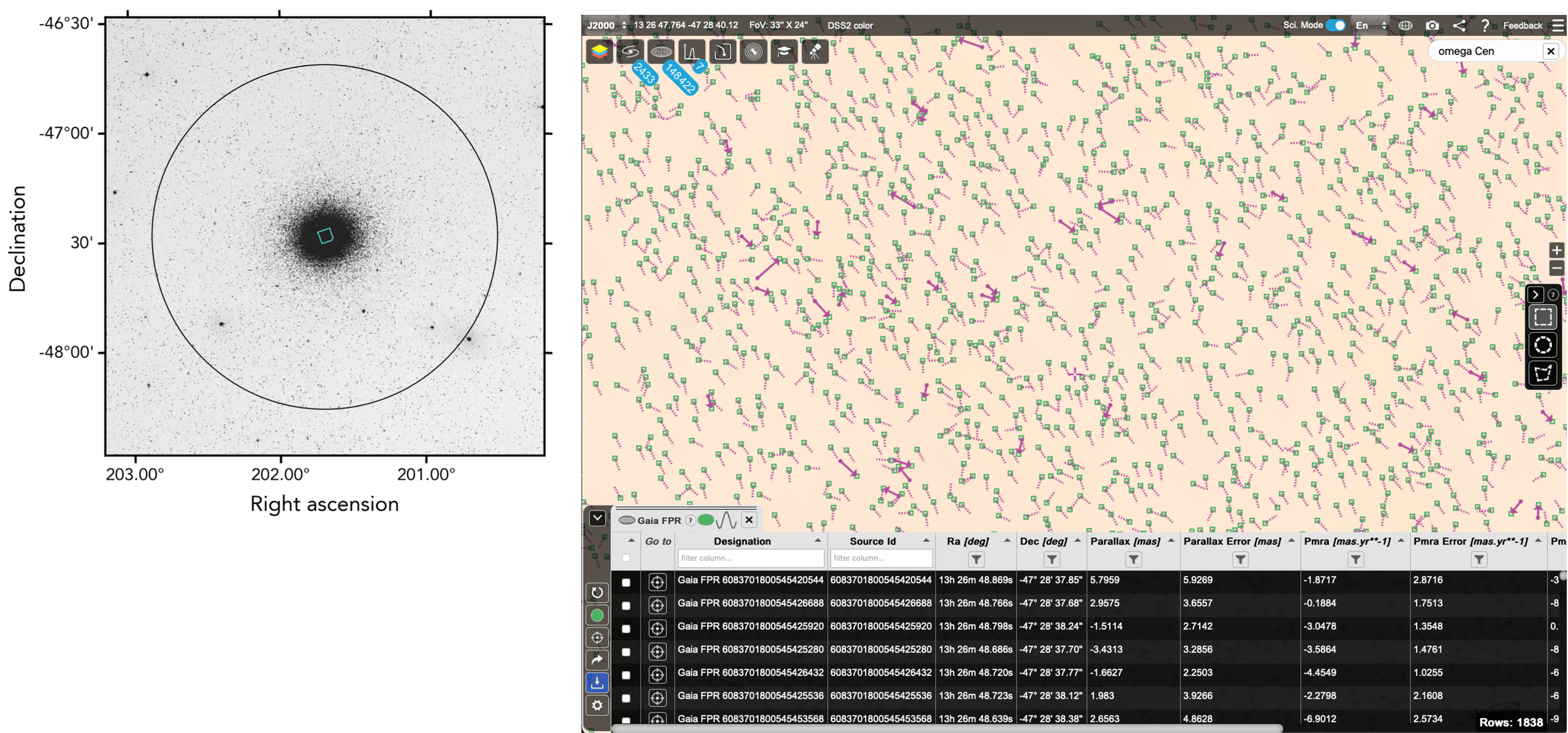
On 10 October 2023, the Gaia mission published its focused product release (FPR). The FPR contains five data products: (1) astrometry and photometry from engineering images taken in the core of the ω Centauri globular cluster, (2) updated astrometry for 156,823 Solar System objects based on 66 months of observations, (3) results of the search for gravitationally-lensed quasars, (4) radial-velocity time series for 9614 long-period variables, and (5) a study of diffuse interstellar bands extracted from aggregated medium-resolution spectra. The 12 tables of this data release, accessible through the Table Access Protocol and the bulk-download repository of the Gaia ESA Archive (and the partner data centres of the Gaia Data Processing and Analysis Consortium), have meanwhile been queried thousands of times.
The first data product, in the form of the gaiafpr.crowded_field_source table, has also been included in ESASky. The image above nicely demonstrates the power of this new data set. Since the Gaia DR3 source density in the core of the cluster is severely reduced as a result of the astrometric crowding limit of the instrument, the novel use of special engineering images acquired in the Gaia Sky Mapper instrument has allowed to recover astrometry (position, parallax, and proper motion) for 526,457 and photometry (mean G-band magnitude and flux) for 526,587 new sources. The left panel (Figure 13 in Gaia Collaboration, Weingrill, et al. 2023) shows the Digitized Sky Survey view of ω Cen with the extent of the new data (black circle) and reference data from the Hubble Space Telescope (HST) from Bellini et al. (2017) (teal square). The right panel shows a few thousand of the new Gaia FPR sources, with their proper motions, in a small field (33 x 24 arcsec2) in the core of the cluster as visualised in ESASky. The combined Gaia DR3 + FPR catalogue, which has 868,307 objects in a 0.8-degree radius from the cluster centre(*), goes more than three magnitudes deeper than Gaia DR3 while 90% of the new FPR sources match HST data and can thus be regarded as reliable.
This data is just a teaser for Gaia DR4, which will bring similar extensions of Gaia's nominal observations for eight other dense areas in the sky. Watch this space!
(*) This is the result of the following Astronomical Data Query Language (ADQL) query launched in the Gaia ESA Archive:
SELECT source_id, designation, ref_epoch, ra, ra_error, dec, dec_error, pmra, pmra_error, pmdec, pmdec_error, phot_g_mean_mag, l, b, n_scans, 'fpr' as origin
FROM gaiafpr.crowded_field_source
UNION SELECT source_id, designation, ref_epoch, ra, ra_error, dec, dec_error, pmra, pmra_error, pmdec, pmdec_error, phot_g_mean_mag, l, b, -1 AS nscans, 'dr3' as origin
FROM gaiadr3.gaia_source
WHERE DISTANCE(POINT(201.69399972775088, -47.484610741298994), POINT(ra, dec)) < 0.8
Images: ESA/ESDC
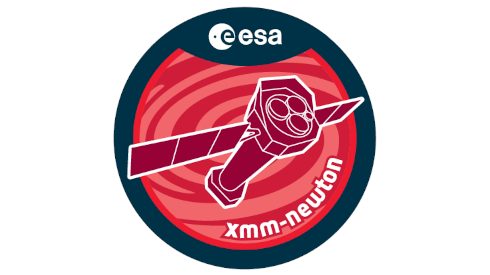
The latest XMM-Newton Optical Monitor (OM) Serendipitous Ultraviolet Source Survey Catalogue (XMM-OM-SUSS6) has been included in the XMM-Newton Science Archive (XSA).
Full story
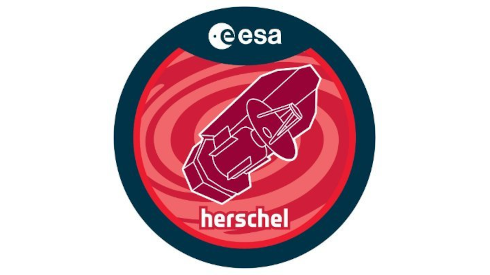
Two new UPDPs have been ingested in the Herschel Science Archive: HGBS and GOALS; representing products of higher quality than those generated by the standard instrument pipelines, or complementary to them.
Full story
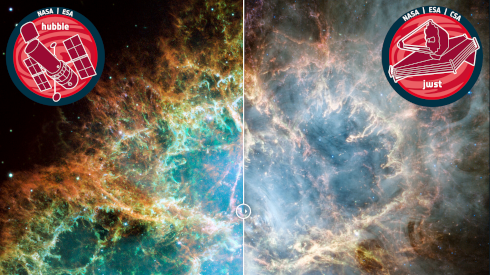
Read about the exciting new features in the latest releases of the European JWST and HST Science Archives.
Full story
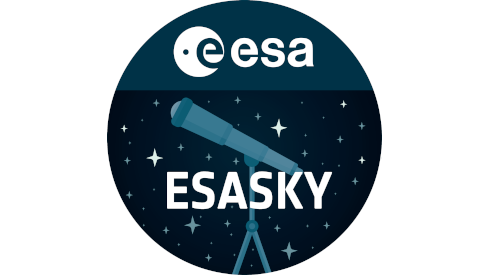
The latest ESASky releases include Euclid outreach images, wide-angle view Webb images of the Orion Nebula, the Gaia Focused Product Release Crowded Field Source catalogue, and the XMM-Newton EPIC-pn instrument added to the planning tool.
Full story

ESDC updates the TAP common library monthly, incorporating new features and enhancements for improved compliance.
Full story

The new DOIs TAP Service was presented at ADASS XXXIII along with many other presentations by the ESDC.
Full story
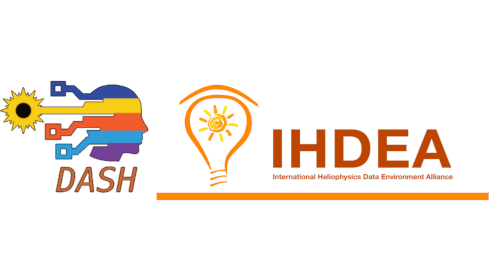
The next International Heliophysics Data Environment Alliance (IHDEA) / Data, Analysis, and Software in Heliophysics (DASH) meetings will be hosted by ESA, at ESAC, Madrid, 14-18 October 2024!
Full story
Discover new optical and ultraviolet sources with the XMM-Newton Science Archive!
By Elena Jiménez (XMM-Newton Support Archive Scientist, Quasar Science Resources for ESA), Simon Rosen (XMM-Newton Instrument Scientist, SERCO for ESA), María Santos Lleó (Science Operation Manager), Peter Kretschmar (XMM-Newton Archive Scientist) and the ESDC XSA team.
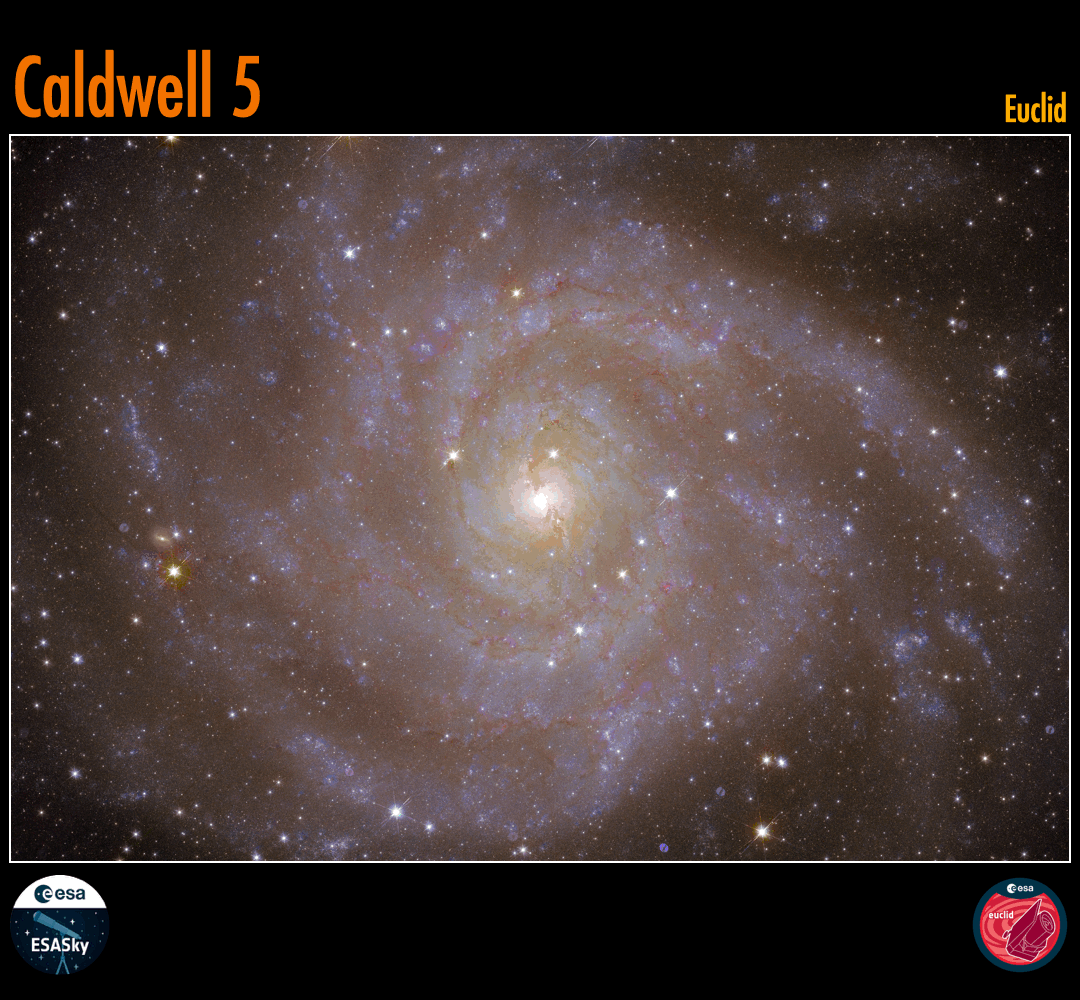

The latest XMM-Newton Optical Monitor (OM) Serendipitous Ultraviolet Source Survey Catalogue (XMM-OM-SUSS6) has been included in the XMM-Newton Science Archive (XSA). The catalogue contains data from 12,057 OM observations, obtained between February 2000 and November 2022. The catalogue comprises photometric measurements from 9.92 million detections of sources, above 1 million more sources than in the previous version of the catalogue. The sources have been observed with one or more optical and/or UV filters. These detections correspond to 6.66 million unique sources, of which 1.23 million have more than one detection in the catalogue, thus facilitating the analysis of potential variability on timescales of days to years.
ESASky version 5.4, released November 2023, includes a new planning tool for XMM-Newton  : the EPIC-pn footprint template can now be displayed over an ESASky field, allowing the XMM-Newton observers to prepare the pointing and position angles of their requested observations.
: the EPIC-pn footprint template can now be displayed over an ESASky field, allowing the XMM-Newton observers to prepare the pointing and position angles of their requested observations.
The above figure shows the spiral galaxy Caldwell 5, also known as IC 342, located around 11 million light-years from us. This galaxy has been chosen as example here because its image is one of the five Euclid first images released early November. Caldwell 5 has been observed with Euclid in the near-infrared and with XMM-Newton in the optical, ultraviolet and X-rays. XMM-Newton has made six different observations of Caldwell 5 related to three different proposals. In these observations, XMM-OM-SUSS6 includes more than 7,000 source detections in the optical and ultraviolet OM exposures (see the bottom picture); from them, around 2,800 are unique sources. The XMM-Newton EPIC camera shows a different view of this spiral galaxy in X-rays. The associated XMM-DR13 catalogue, also available from XSA, detects 346 sources in the galaxy field. The figure also shows the XMM-Newton EPIC-pn footprint template superimposed on the Euclid image of Caldwell 5. The footprint template has been arranged to locate the galaxy centre at the aim point of XMM-Newton and the angle of the footprint template was changed to optimise the position of the interesting sources within the EPIC-pn CCDs.
Images: ESA/ESDC
New User Provided Data Products (UPDPs) available in the Herschel Science Archive
By Eva Verdugo (Herschel and PLATO Archive Scientist)
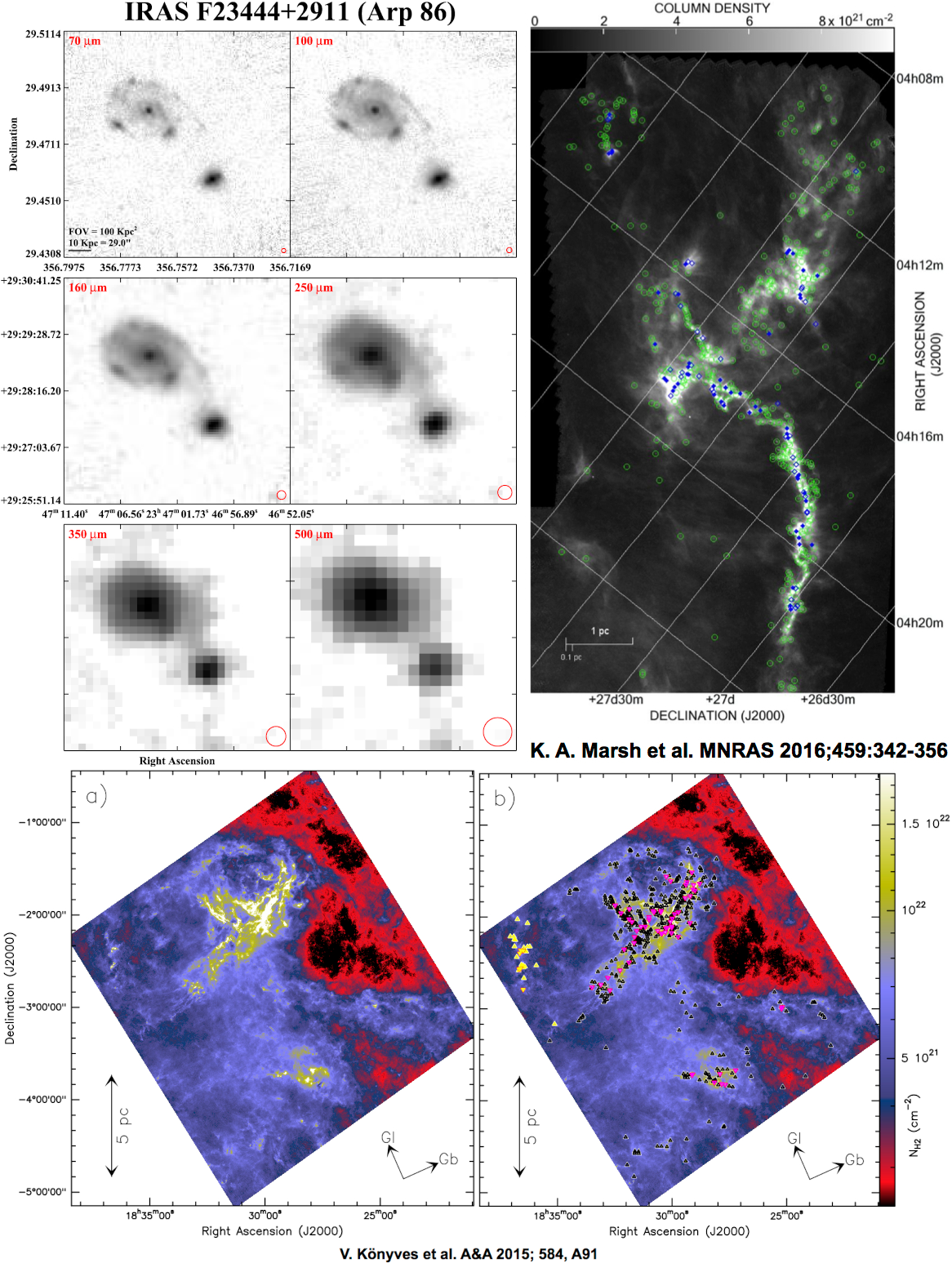
Two new UPDPs (User Provided Data Products, generated by the scientific community) have been ingested in the Herschel Science Archive, representing products of higher quality than those generated by the standard instrument pipelines, or complementary to them.
HGBS: PACS maps (70 and 160 microns) and SPIRE maps (250, 350 and 500 microns) of the Aquila and Taurus L1495 cloud complexes. The associated catalogues include the detection of 525 starless cores of which ~10-20 per cent are gravitationally bound and therefore presumably pre-stellar in the Taurus region plus 651 starless cores (~60 per cent pre-stellar) and 58 proto-stellar cores in the Aquila region.
GOALS: Far-infrared images and photometry of 179 LIRGs (log(L_IR/L_sun) = 11.0-11.99) and 22 ultra-luminous infrared galaxies (ULIRGs: log(L_IR/L_sun) > 12.0) taken with PACS and SPIRE. The image atlas displays each target in the three PACS bands (70, 100, and 160 microns) and the three SPIRE bands (250, 350, and 500 microns), optimised to reveal structures at both high and low surface brightness levels, with images scaled to simplify comparison of structures in the same physical areas of ~100 x 100 kpc2.
The full list of UPDPs currently ingested in the Herschel Science Archive is available at: https://www.cosmos.esa.int/web/herschel/user-provided-data-products
The ingestion of UPDPs is a combined effort of the remaining very limited resources from the former ESAC Herschel Science Centre plus the ESAC Science Data Centre team. Henceforth, this is an activity for which we cannot ensure continuity although the ingestion of already provided data products is foreseen at best effort basis.
Image: PACS and SPIRE images of Arp 86 from the GOALS project (top left). HGBS image of the H2 column density map of the Taurus region at 18.2" angular resolution with the location of the detected cores (top right; green circles = unbound starless, filled blue diamonds = pre-stellar, open blue diamonds = candidate pre-stellar). HGBS image of the H2 column density map of the Aquila region at 18.2" angular resolution (bottom). In the right panel with the positions of the 446 candidate pre-stellar cores and 58 proto-stellar cores identified.
Images: HGBS and GOALS projects
Automated generation of Jupyter Notebooks and new spectral visualization tool in the European JWST and HST Science Archives
By Javier Espinosa (RHEA Group for ESA), Maria Arevalo (RHEA Group for ESA), Marcos López-Caniego Alcarria (Aurora Technology B.V. for ESA), Monica Fernandez Barreiro (RHEA Group for ESA), Christopher Evans (ESA), Paule Sonnentrucker (ESA) and Anthony Marston (ESA).
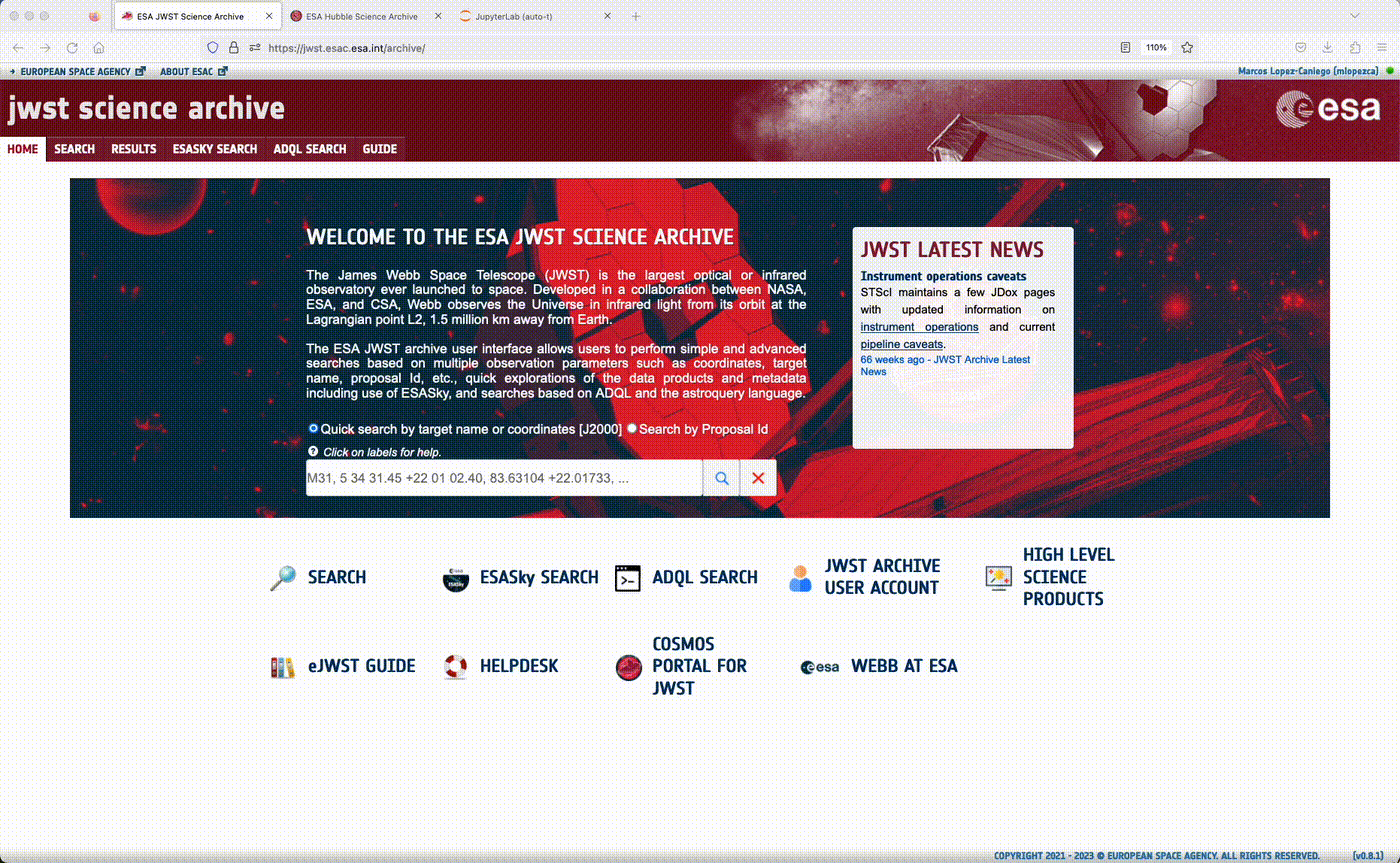
In a double impact for the astronomical community, new versions for both the European James Webb and Hubble Science Archives have been recently released. These new upgrades include a set of enhancements that promise to change the way scientists explore scientific data and navigate from visual user interfaces to powerful programmatic scripts. Keep reading and discover the new features!
New access to data is now made available in the European James Webb Science Archive (eJWST)! The eJWST Science Archive has extended its user-friendly interface by offering the possibility of automatically generating Jupyter Notebooks! Based on your current search parameter and with only a simple click, you will download a fully functional Jupyter Notebook auto-generated file with Astroquery commands about how to execute the same search, get the list of products available and download them on demand! Jupyter Notebooks generated in the Archive can be easily uploaded to ESA Datalabs, as another layer of convenience. And if this is not enough, do not worry, the User Manual is also included. There is also now a direct link to High Level Science Products on the Home Page to access valuable data products and further resources hosted at STScI's Mikulski Archive for Space Telescopes.
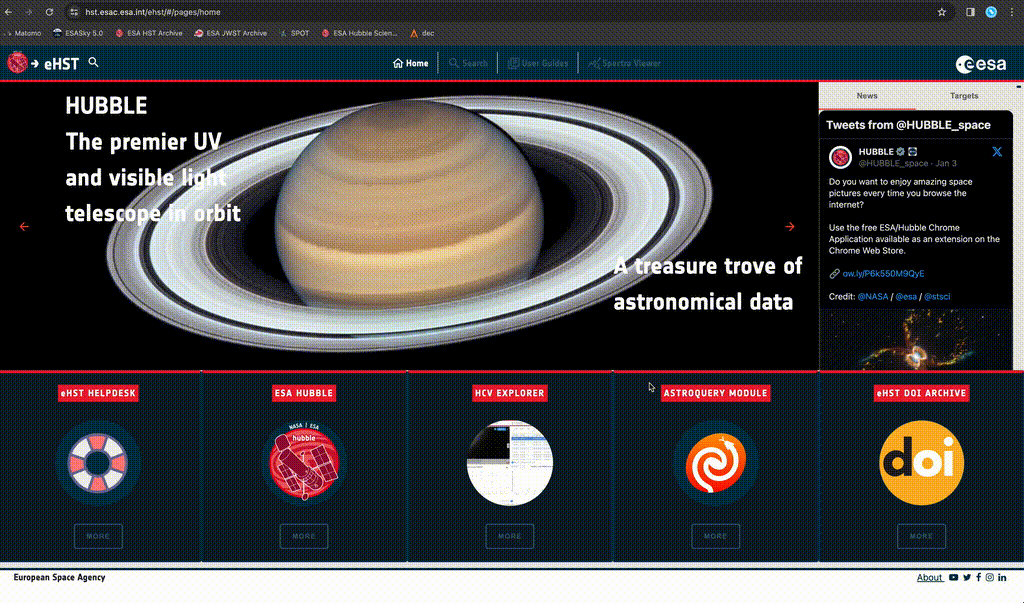 For easy inspection of spectroscopic data from the precious archive of HST observations, the European Hubble Science Archive introduces a Spectra Viewer, a quick-look tool to load a set of FITS files from the STIS and COS instruments. This is the initial step for deeper analysis, so now users can load a variety of observations, show the spectra in one or multiple views and explore the data before even downloading the files.
For easy inspection of spectroscopic data from the precious archive of HST observations, the European Hubble Science Archive introduces a Spectra Viewer, a quick-look tool to load a set of FITS files from the STIS and COS instruments. This is the initial step for deeper analysis, so now users can load a variety of observations, show the spectra in one or multiple views and explore the data before even downloading the files.
These functionalities will be valuable for all kinds of research, both for researchers who have their scripts for data analysis and for those who love a more interactive environment. They are the result of the collective effort of our team of engineers and scientists for both European Hubble and James Webb Science Archives and the objectives are clear: enhancing the workflow from data exploration to deeper analysis and enhancing close collaboration between researchers, to unlock new insights into the mysteries of the universe.
Images: ESA/ESDC
ESASky's latest outreach images and data additions
By Deborah Baines (Quasar Science Resources for ESA), Philip Matsson (Winter Way for ESA), Marcos López-Caniego (Aurora Technology B.V. for ESA), Henrik Norman (Winter Way for ESA), Javier Espinosa (Rhea Group for ESA), Elena Puga (Winter Way for ESA), Alexandros Marantos (Winter Way for ESA)

In October 2023, ESASky, in collaboration with Mark McCaughrean (Principal Investigator, ESA) and Sam Pearson (ESA), the JWST mission, and ESA communications, released two wide-angle view Webb outreach images of the Orion Nebula. These images were captured using Webb's near-infrared camera, NIRCam, and were transformed into two high-resolution mosaics by the PI, featuring one from the short wavelength channel and another from the long wavelength channel. The images can be explored using the Webb Outreach images feature in ESASky and with the Orion Nebula target list that highlights some of the most interesting objects, including the newly discovered JuMBOs (Jupiter-Mass Binary Objects), Jupiter-sized binary planets found to be unconnected to any star (Pearson & McCaughrean, 2023).
Additionally in October, more data was added to ESASky, in particular the Gaia Focused Product Release Crowded Field Source catalogue (in the ω Centauri region) and 5 WMAP and 8 QUIJOTE radio HiPS, along with an updated GALEX HiPS.
On 7th November, ESASky performed a coordinated release in collaboration with the ESA Euclid mission and ESA communications. This release introduced a new Euclid Outreach images feature that showcases the five Euclid Early Release Observation (ERO) outreach images. These spectacular colour images, featuring the Perseus Cluster of galaxies, spiral galaxy IC 342, irregular galaxy NGC 6822, globular cluster NGC 6397, and the Horsehead Nebula, are zoomable in ESASky down to the resolution of the Euclid instruments and can be explored with the Euclid Early Release Targest list. Furthermore in this release, the XMM-Newton EPIC-pn instrument footprint has been incorporated into the Observations Planning Tool, providing valuable assistance to users preparing XMM-Newton proposals.
Image: ESA/ESDC
TAP: New Features and Significant Changes
By Jose Osinde (RHEA Group for ESA), Carlos Rios (RHEA Group for ESA), Ignacio León (Aurora Technology B.V. for ESA), Jorge Fernandez (RHEA Group for ESA) & Maria Henar Sarmiento (Aurora Technology B.V. for ESA)

ESDC release a new version of the Table Access Protocol (TAP) common library once a month, including new features and various enhancements to improve compliance. The latest releases incorporate two key enhancements:
- The TAP/DataLink authentication mechanism now aligns with IVOA recommendations. This enables graphical tools, such as the latest version of TOPCAT, to seamlessly prompt users for credentials, facilitating authenticated logins.
- New Command for Updating Tables in a TAP service: Previously, manually recreating table information in the TAP service proved to be both time-consuming and cumbersome. The new release introduces a new command that enables table updates without sacrificing any essential information previously stored. This improvement simplifies the process for missions looking to transition to an updated TAP version or aligning TAP tables with modifications in the database.
Image: IVOA
New DOIs TAP Service presented at ADASS XXXIII
By Maria Henar Sarmiento (Aurora Technology B.V. for ESA) & Jose Osinde (RHEA Group for ESA)
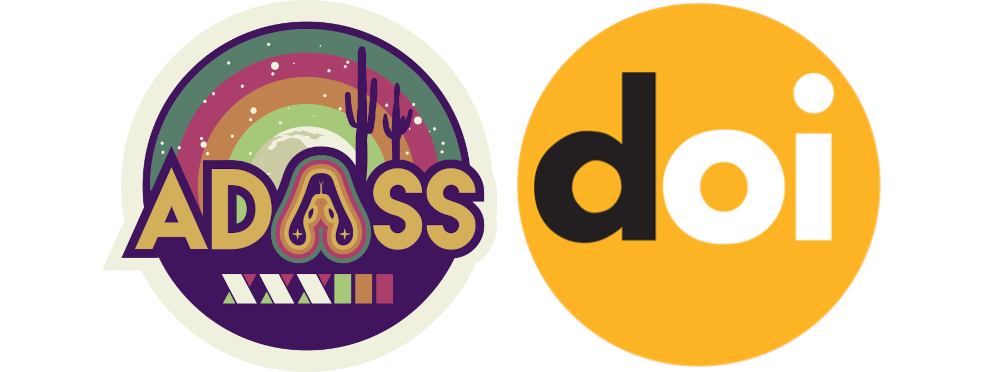
The Astronomical Data Analysis Software and Systems (ADASS) conference is held each year at a different hosting astronomical institution. The conference provides a forum for scientists and programmers concerned with algorithms, software and software systems employed in the acquisition, reduction, analysis, and dissemination of astronomical data. An important element of the program is to foster communication between developers and users with a range of expertise in the production and use of software and systems. The program consists of invited talks, contributed oral and display papers, tutorials, user group meetings and special interest group meetings (called BOFs). Members of the ESDC, representing ESA, participate every year in this conference to present the most relevant advances within the SW developed in the department.
In this edition, in addition to other magnificent presentations carried out by Jos de Bruijne (Europe's revolutionary sky surveyors: Gaia and Euclid); Deborah Baines (ESASky: Unveiling the Universe through Multi-Wavelength and Time-Domain Exploration); Marcos Lopez-Carriego, Javier Espinosa, Maria Arévalo (Navigating ESA HST and JWST Science Archives through Automated Jupyter Notebooks); Javier Espinosa (SPOT: A collaborative framework for Planetary Science Operations Planning); Adrian Trejo (ESA Heliophysics archives interoperability and data access enhancements); and Sara Nieto (Exploring the Dark Side of the Universe: The EUCLID Scientific Archive System); the ESDC also presented the new TAP service that gives access to DOIs assigned to each dataset stored by the department (Maria Henar Sarmiento, DOIs at the ESDC and the new ESDC DOI TAP Service).
In the past, ESA DOIs could be accessed in two main ways: through Google Dataset Search (Masson et al., 2021) and via the ESA Data Discovery Portal, where all ESA data holdings have been assigned dedicated DOIs (C. Arviset et al., PV2023). A third way was recently added via the ESA DOI TAP Service.
The ESA DOI TAP Service enables researchers, science centres, and institutions to connect their tools via the TAP protocol, allowing them to resolve DOIs associated with specific proposals or experiments in an easy, clean, and fast way. The service not only provides the DOI linked to a particular proposal or dataset but also offers other valuable information, such as citation guidelines and the link to the landing page associated with the DOI.
Image: ADASS XXXIII
IHDEA/DASH meetings
By Arnaud Masson (Heliophysics Archives Science Lead)

The next International Heliophysics Data Environment Alliance (IHDEA) / Data, Analysis, and Software in Heliophysics (DASH) meetings will be hosted by ESA, at ESAC, Madrid, 14-18 October 2024!
The inaugural workshop for data science and software in Heliophysics (DASH) was held on 9-11 October 2023 in the Applied Physics Laboratory/John Hopkins University in Laurel, Maryland. Supported by NASA and NSF, DASH serves as a forum for scientists and software developers to present and discuss algorithms, software, and data systems used in the acquisition, reduction, analysis, and dissemination of data for Heliophysics, including space and ground-based measurements as well as models. The meeting connects practitioners across institutions, and international participation is key to success. All ranges of experience were welcome. The program contained invited and contributed talks (with virtual participation possible), as well as posters (in-person only). All presentations are available at https://dash.heliophysics.net/.
The first DASH meeting was followed by the 7th International Heliophysics Data Environment Alliance (IHDEA) meeting on 12-13 October, held at the same location. Increasing collaboration and coordination through the use of standard formats (for both data and metadata) and community-based data tools are critical for enabling interoperability of data systems and services and improving sharing of space-based, ground-based, and model-based heliophysics data sets. We are researchers, simulators, information technology experts, developers and data engineers dedicated to advancing science and improving the heliophysics data environment. We are from many different organizations, including CNES, ESA, JAXA (represented by the major stakeholder: ISAS), Nagoya University-ISEE, NASA (represented by the following major stakeholders: SPDF, SDAC, HPDE, SPASE, CCMC). Presentations are available here.
Image: IHDEA/DASH









 : the EPIC-pn footprint template can now be displayed over an ESASky field, allowing the XMM-Newton observers to prepare the pointing and position angles of their requested observations.
: the EPIC-pn footprint template can now be displayed over an ESASky field, allowing the XMM-Newton observers to prepare the pointing and position angles of their requested observations.






